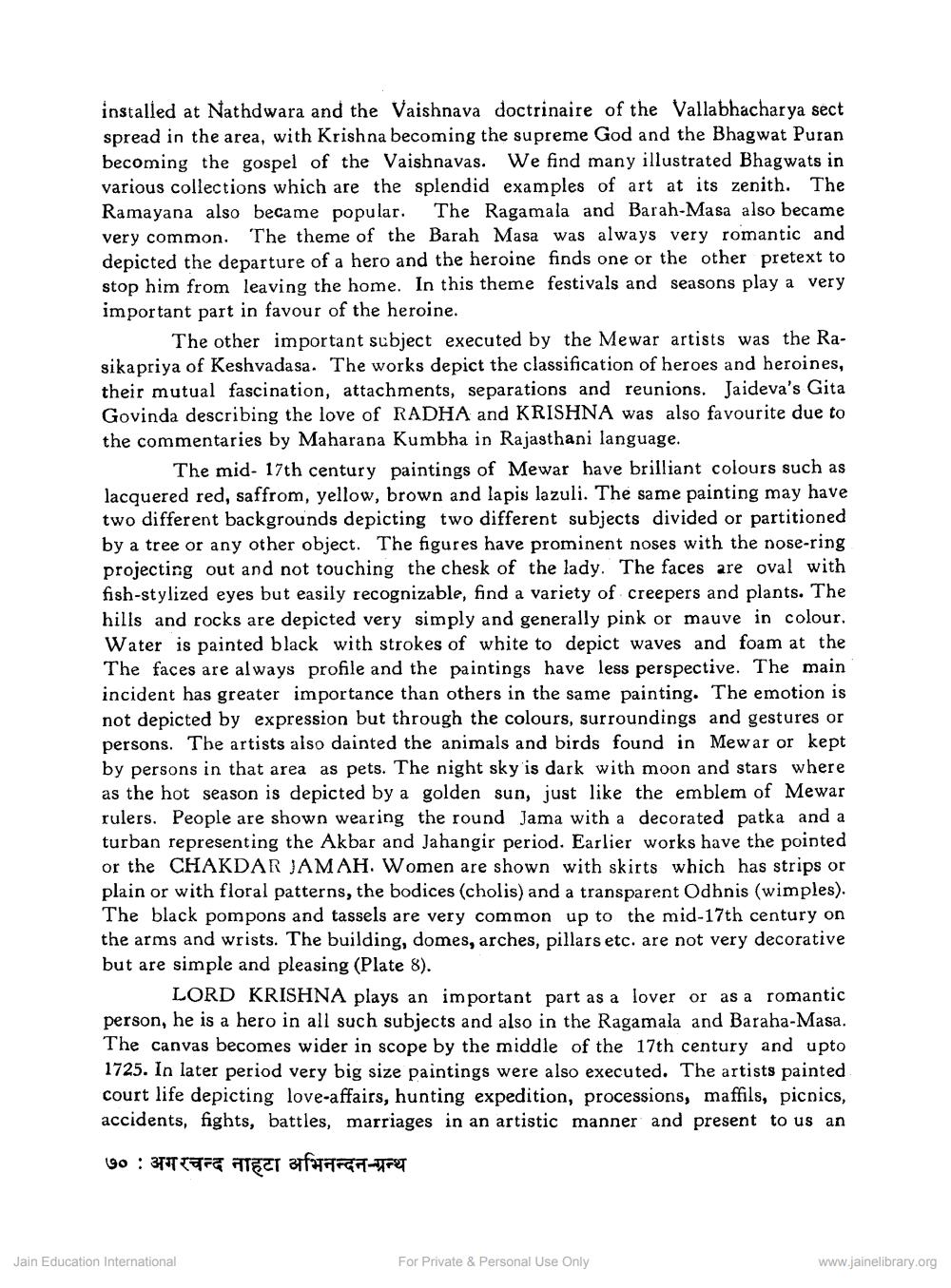Book Title: Mewar Painting Author(s): Kuwar Sangram Singh Publisher: Z_Nahta_Bandhu_Abhinandan_Granth_012007.pdf View full book textPage 3
________________ installed at Nathdwara and the Vaishnava doctrinaire of the Vallabhacharya sect spread in the area, with Krishna becoming the supreme God and the Bhagwat Puran becoming the gospel of the Vaishnavas. We find many illustrated Bhagwats in various collections which are the splendid examples of art at its zenith. The Ramayana also became popular. The Ragamala and Barah-Masa also became very common. The theme of the Barah Masa was always very romantic and depicted the departure of a hero and the heroine finds one or the other pretext to stop him from leaving the home. In this theme festivals and seasons play a very important part in favour of the heroine. The other important subject executed by the Mewar artists was the Rasikapriya of Keshvadasa. The works depict the classification of heroes and heroines, their mutual fascination, attachments, separations and reunions. Jaideva's Gita Govinda describing the love of RADHA and KRISHNA was also favourite due to the commentaries by Maharana Kumbha in Rajasthani language. The mid- 17th century paintings of Mewar have brilliant colours such as lacquered red, saffrom, yellow, brown and lapis lazuli. The same painting may have two different backgrounds depicting two different subjects divided or partitioned by a tree or any other object. The figures have prominent noses with the nose-ring projecting out and not touching the chesk of the lady. The faces are oval with fish-stylized eyes but easily recognizable, find a variety of creepers and plants. The hills and rocks are depicted very simply and generally pink or mauve in colour, Water is painted black with strokes of white to depict waves and foam at the The faces are always profile and the paintings have less perspective. The main incident has greater importance than others in the same painting. The emotion is not depicted by expression but through the colours, surroundings and gestures or persons. The artists also dainted the animals and birds found in Mewar or kept by persons in that area as pets. The night sky is dark with moon and stars where as the hot season is depicted by a golden sun, just like the emblem of Mewar rulers. People are shown wearing the round Jama with a decorated patka and a turban representing the Akbar and Jahangir period. Earlier works have the pointed or the CHAKDAR JAMAH Women are shown with skirts which has strips or plain or with floral patterns, the bodices (cholis) and a transparent Odhnis (wimples). The black pompons and tassels are very common up to the mid-17th century on the arms and wrists. The building, domes, arches, pillars etc. are not very decorative but are simple and pleasing (Plate 8). LORD KRISHNA plays an important part as a lover or as a romantic person, he is a hero in all such subjects and also in the Ragamala and Baraha-Masa. The canvas becomes wider in scope by the middle of the 17th century and upto 1725. In later period very big size paintings were also executed. The artists painted court life depicting love-affairs, hunting expedition, processions, maffils, picnics, accidents, fights, battles, marriages in an artistic manner and present to us an ७० : अमरचन्द नाहटा अभिनन्दन-ग्रन्थ Jain Education International For Private & Personal Use Only www.jainelibrary.orgPage Navigation
1 2 3 4 5 6 7 8 9
